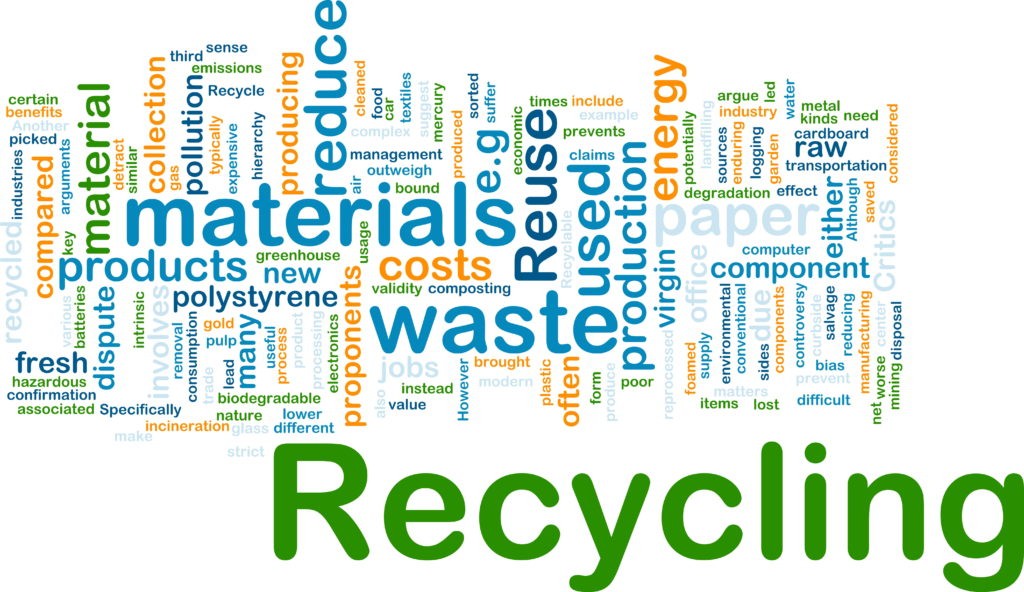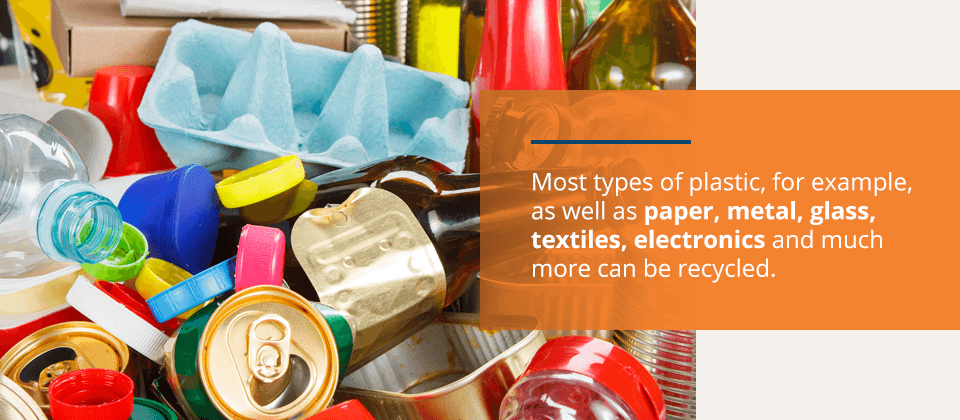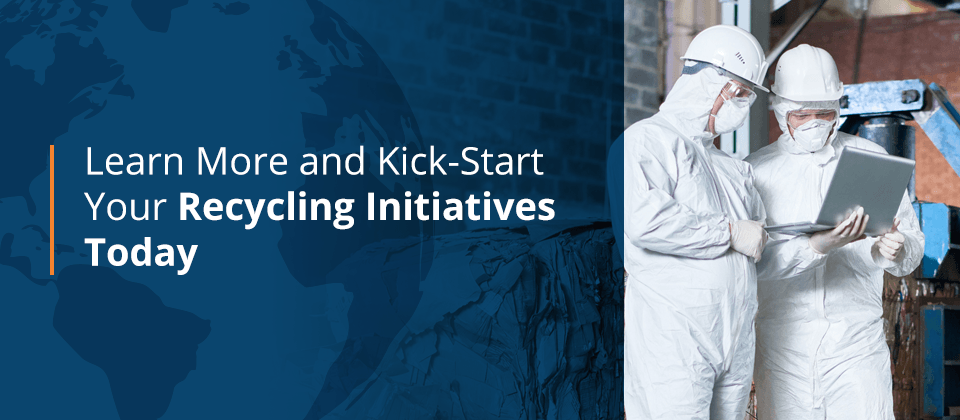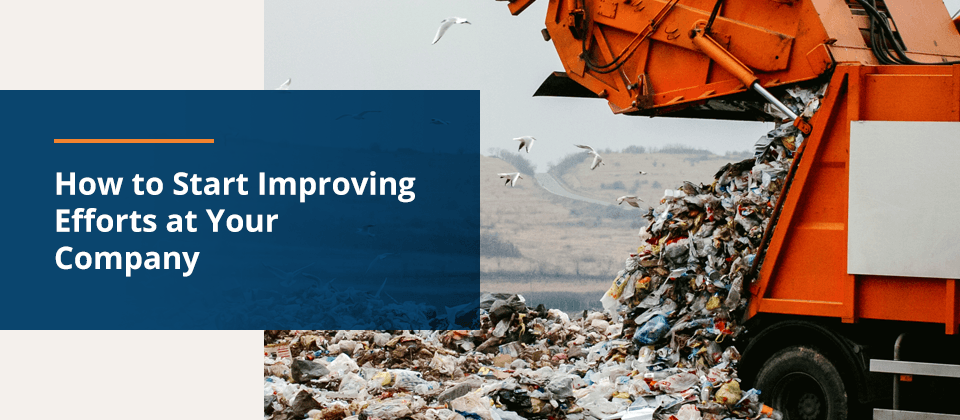Waste Reduction and Recycling Tips for Manufacturers


As consumers, we’re constantly advised to reduce our consumption and our waste. We’re chastised about purchasing anything that will just be thrown away and frowned upon for using too much plastic. We all feel a little guilty as we scrape leftovers into the trash, or throw out food that has gone bad on the shelves.
But despite all this pressure that’s put on consumers, it’s manufacturers who are responsible for huge amounts of waste produced across the country. It’s almost ironic that one household might feel bad for throwing away a stale box of crackers when huge manufacturing plants are wasting far more through inefficiency and an inaccurate representation of actual supply and demand.
So what can you do, as a company, to work towards reducing manufacturing waste? As it turns out, there’s plenty you can do. Today, we’re here to give you a quick and easy guide to just a few of the ways your company can work toward reducing waste and promoting recycling in the manufacturing industry.
Why Monitor Waste and Recycling?
There’s an obvious answer to this question. Your company should care because manufacturing recycling is good for the planet and excessive amounts of waste hurt it. Manufacturers and consumers alike exist on this same planet and depend upon its resources for life. If we don’t care for the planet, who will?
Beyond this, however, there’s an additional reason to care about the volume of materials or products your company might be wasting. Wasted materials actually count as an economic loss for manufacturers. Conversely, anything saved or recycled counts as a financial gain. In other words, it’s beneficial to your bottom line to recycle.
For example, let’s say that your company was producing a specific product, and you anticipated a huge demand for this product. To meet this expected demand, you produced huge numbers of this product. Unfortunately, your calculations were off, and the actual demand fell far short of the projected numbers. This type of overproduction means your company ends up with many unsellable products that cost good money to produce.
If your company simply threw these away, that would be an enormous monetary loss for you, as well as a drain on the earth’s resources and an extra addition to your local landfill. Instead, it makes more sense from both an environmental and an economic standpoint to recycle these products, reusing the material to create new products that will sell better.

By monitoring the amount of waste production and recycling that goes on in your facilities, you can gain a great deal of insight into how well your company is responding to the market’s demands. For example, if you see your company throwing away lots of products, you might realize it’s time to scale back production of that product. You might also decide it’s time to come up with new recycling initiatives to salvage some of the money that went into making those products.
Recycling Tips
Have you decided it’s time to take waste in your manufacturing facility seriously? If so, then we congratulate you. This is a big step towards achieving a healthier earth — which will benefit everyone — and towards protecting your economic bottom line. While starting any new initiative like this is always a little rocky, it will undoubtedly pay off in the long run.
Looking for some concrete ways to get started and make some real headway with your recycling endeavors? Here are a few of our best tips. We encourage you to look into each of these categories on their own and brainstorm ways to incorporate them into your operations.
1. Think About the Types of Recyclable Materials
The unfortunate truth is that not every material is recyclable. As nice as it would be if this were otherwise, some materials simply aren’t salvageable once they’ve already been used. The good news, however, is that many materials are recyclable. Most types of plastic, for example, as well as paper, metal, glass, textiles, electronics and much more can be recycled.

Think about what types of recyclable materials your facility frequently deals with. Do you often use cardboard? Plastic? Glass? Keep in mind that this doesn’t just have to be a material that you use in your manufacturing process. It might also be a material that you use for packaging. Maybe many of your shipments arrive strapped to wooden pallets, for example, and the plastic that was holding them in place is just thrown away.
2. Determine the Largest Group of Recyclable Materials
Take a good look at what types of materials your facility discards the most frequently, and this will give you a great deal of insight into where improvements can be made. For example, maybe your company has a significant amount of plastic waste, but not so much with textiles.
Try to make some concrete determinations about which materials your company seems to have a consistent problem with wasting. Maybe this means identifying your number one problem, or it might mean making a list of your top three contenders. One way you can do this is by monitoring all the waste produced in your facilities for a day, a week or a month. It might also mean asking your workers to keep a list of the things they discard.
3. Pay Attention to the Workflow
Now that you’ve identified some of the most problematic materials in your workplace, your goal is to analyze the typical workflow to determine a way to separate these materials from the rest. Because your company has goals to meet, however, it’s critical to decide on an efficient way to do this. Ideally, this method should disturb the ordinary flow of work as little as possible, allowing workers to carry on with their business almost exactly as usual. Pay close attention to the patterns in a typical work day and brainstorm solutions.
4. Strategically Place Recycling Containers
After a period of analyzing and studying the natural flows and rhythms of your facility’s work floor, you should begin to gain an idea of where recycling bins and containers would best be placed. Maybe they’re at the end of assembly lines, or at the start of them. Maybe they’re around the perimeter of the room, or just inside the loading bay doors. The precise location is something that will likely be unique to every facility. What’s important is that they’re clearly labeled with what materials are supposed to go in them.
Don’t be afraid to play around with this bin placement as you work out a system that works well for everyone. Just because you start out placing the containers in one place doesn’t mean they have to stay there. Keep trying different arrangements until you find the best one.
5. Outline the Procedures
It’s hardly fair to simply place containers around the production floor all of a sudden without alerting your employees to the new procedures. Instead, you’ll want to take the time to alert everyone to the changes your company is making. Be sure to explain why you’re making the changes, as well as what they can all do to help. Transitions such as this are always smoother when everyone is participating willingly and eagerly.
6. Create Additional Documentation
As the new recycling program begins to take off, your company may want to consider creating additional forms of documentation. This might be something like a recycling manual, which can serve as an introduction to the project to your employees, or a great orientation material to give to incoming employees. It can also serve as a wonderful resource for yourself in the future as you look back on the process, or for any successor you may have who might wonder about the scope and details of your project in the months or years to come.
7. Continually Evaluate for Improvement
No system is perfect on the first try. Everything improves with time, and the same will likely be true of your company’s new recycling initiative. As time goes on, you’ll probably see ways you can tweak it to make it better. You might poll your employees and ask if they have any suggestions. Maybe the system will naturally evolve to become more efficient and more productive. One thing’s for sure, however, and that is the fact that a good recycling system is worth taking the time to perfect.
Waste Reduction Tips

While recycling manufacturing electronics, plastics, metals and other materials is great and certainly worth pursuing, waste reduction is another worthy pursuit that should not be neglected in favor of solely seeking recycling methods. Just a few of the steps you can take to reduce the amount of waste your production facilities are producing include:
1. Build a System Around Waste
Some waste is inevitable, at least for the present. But this doesn’t mean it has to be inefficient. Accept that some waste will be a natural result of your facility, and develop a system to deal with this waste as efficiently and neatly as possible, without wasting other materials in the process.
2. Reduce the Use of Hazardous Materials
Depending on the type of products you manufacture, you may have no choice but to use hazardous materials as part of the process. In spite of this, however, make an effort to limit your use of these materials as much as you can. Substitute non-hazardous materials whenever possible. This is beneficial because toxic substances are particularly difficult, expensive and dangerous to dispose of.
3. Monitor Your Waste Stream Carefully
What are the trends in your facility’s waste habits? Is it unused parts? Overproduction? Packaging materials? Try to get a feel for which types of items are getting wasted at your facility, and where they’re originating. Once you have a good idea of the answers to these questions, you can more effectively start to brainstorm ways your company can correct these problems.
4. Establish a Mission
Goals are easier to achieve once you make a concrete statement about what exactly it is you want to accomplish, and you let others know about that goal. So think of a milestone you’d like to reach. Maybe that’s 30 percent less waste by the end of the next five years, or maybe it’s eliminating all glass products being wasted. Whatever your goal is, make a statement. Type up this mission and send it out to the whole company. Talk to people about it, get them excited and let them help brainstorm ways to make it happen. This will keep everyone motivated and actively working towards this endgame.
5. Create a Plan and Involve Your Employees
Now that you have a goal to work towards, it’s time to think about how to achieve it. Gather a committee and work together to think of solutions that will help your company complete this mission. Maybe you’ll choose to swap out one of your packaging materials with a recyclable alternative. Perhaps you’ll eliminate a hazardous substance from your workplace. Ideally, this goal will involve your company employees, allowing everyone to participate in this goal and work towards a safer, healthier, more productive and more sustainable workplace for everyone.
How to Start Improving Efforts at Your Company
At a typical manufacturing plant, and likely at your facilities as well, there are many places where perfectly good materials are simply being tossed into the garbage. It probably isn’t done intentionally, but it’s a simple matter of no one truly paying attention to where these extra pieces end up. Because no one pays attention, they often end up in the dumpster and then in a landfill.
Commit to changing that at your facilities. All it takes to set a change in motion is one person who realizes there’s a problem and makes up their mind to make a difference.
Take a good look at all the different areas of operation in your facility. Look at the packages that arrive. Look at the production line. Look at the packaging you construct to ship your products out in. Where are things slipping through the cracks? Where can you find little ways to intercept items headed for the trash and how can you find better ways to recycle them instead?
It might sound like a daunting prospect at first, but the hardest part is always getting started. Once you have some solid ideas in place and a team of committed individuals working with you, you might be surprised by how much your company can accomplish.

Learn More and Kick-Start Your Recycling Initiatives Today
Excited about the possibilities that recycling could introduce to your manufacturing plant? We are too. Recycling is a great way to give back to our planet, support your local ecosystems and community, and save your company money in the long run. With perks like these, it’s worth it to take those first few steps.
Want to learn more about this and other fascinating topics? Subscribe to our blog here at Global Electronic Services today for regular updates on a wide range of topics relevant to electronics and electronics industries.
